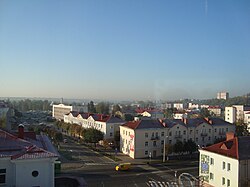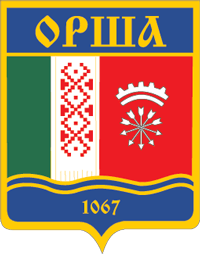Orsha: Difference between revisions
upd |
m pointed the hat to the set index |
||
| Line 1: | Line 1: | ||
{{For|the |
{{For|the inhabited localities in Russia|Orsha, Russia}} |
||
{{Infobox settlement |
{{Infobox settlement |
||
|official_name |
|official_name=Orsha <br> Орша |
||
|nickname |
|nickname= |
||
|image_skyline |
|image_skyline=Orsha_city_2010.JPG |
||
|imagesize = |
|imagesize = |
||
|image_caption = Orsha city |
|image_caption = Orsha city |
||
Revision as of 14:58, 28 October 2014
Orsha Орша | |
|---|---|
 Orsha city | |
 | |
| Country Voblast Raion | Belarus Vitebsk Region Orsha Raion |
| Mentioned | 1067 |
| Area | |
• Total | 38.90 km2 (15.02 sq mi) |
| Elevation | 192 m (630 ft) |
| Population (2009)[1] | |
• Total | 117,225 |
| • Density | 3,000/km2 (7,800/sq mi) |
| Time zone | UTC+2 (EET) |
| • Summer (DST) | UTC+3 (EEST) |
| Postal code | 211030, 211381 - 211394, 211396 - 211398 |
| Area code | +375 216 |
| License plate | 2 |
| Website | Official website |
Orsha (Template:Lang-be, Ворша; Template:Lang-ru Template:IPA-ru) is a city in Belarus in Vitebsk voblast on the fork of the Dnieper and Arshytsa rivers.
Facts
- Location: 54°28′14″N 30°19′05″E / 54.47056°N 30.31806°E
- Population: 125,000 (est. 2004)
- Phone code: +375 216
- Postal codes: 211030, 211381–211394, 211396–211398
History


Orsha was first mentioned in 1067 as Rsha (Template:Lang-ru), making it one of the oldest towns in Belarus. The town was named after the river, which was originally also named Rsha, probably from a Baltic root *rus 'slowly flowing.'[2]
In 1320, Orsha became a part of the Grand Duchy of Lithuania. In 1398-1407, the Orsha castle was built. On September 8, 1514 the famous Battle of Orsha occurred, between allied Grand Duchy of Lithuania with Kingdom of Poland and Russian army.[3] Russians suffered significant defeat, however victorious Grand Duchy of Lithuania did not fully avail its victory.[3]
In 1555, Mikołaj "Czarny" Radziwiłł founded a Calvinist (Protestant) order in Orsha, one of the first in the Belarusian lands. From the sixteenth to eighteenth centuries Orsha was a notable religious centre, with dozens of Orthodox, Protestant and Catholic churches and orders. The town was also home to a large Jewish population.
Orsha was granted Magdeburg Rights in 1620. In 1630, S. Sobal opened the first printing house at the Kuciejna monastery, which became a well-known centre of Cyrillic-alphabet publishing. The town was damaged during the Russo-Polish War (1654-1667), which was a disaster for Grand Duchy of Lithuania. During the First Polish partition the city was taken over by the Russian Empire in 1772, and became part of the Mogilyov Gubernia. Under Russian rule, it was stripped of its Magdeburg Rights in 1776 and went into cultural and economic decline.[citation needed] The population dropped sharply to just about 2,000 inhabitants.[citation needed] The city symbol in 1781 was changed to one which included the symbol of the Russian empire and five arrows.


In 1812, the city was badly burned during Napoleon's invasion. At the time of Orsha had been taken under control of French troops, there was a French writer Marie-Henri Beyle (also known under the pen name Stendhal) in a rank of intendant.[4]
During the First World War, the city was occupied by German forces in February–October 1918. From February 2, 1919, Orsha became a part of Homyel region (Vitebsk region, 1920) of Soviet Russia. After the formation of the Soviet Union, it was transferred to the Byelorussian SSR in 1924.
The population before World War II was about 37,000. The city was occupied by Germany on July 16, 1941. The occupiers founded several concentration camps in the city, where an estimated 19,000 people were killed.[citation needed]
There is a widespread Soviet myth of Katyusha Katyusha multiple rocket launcher's maiden attack of July 14, 1941 at Orsha, destroying a station with several supply trains. This legend obviously conflicts the fact that Orsha remained at the hands of the Soviet Army on July 14 and through July 15, 1941. And even on July 16, 1941 the German troops were unlikely to invade Orsha aboard their supply trains. Thus, had the Katyusha’s rockets fallen on any supply trains on July 16, 1941 those would have been the Soviet trains unable to have left Orsha railroad station. See Russian Wikipedia's article "Гвардейские реактивные минометы" ("Guards Mortars"). The multiple rocket launchers were top secret in the beginning of World War II and any records of their actions in July 1941 were forbidden, which fact led to numerous rumors and myths. The Soviets encouraged and co-ordinated undercover anti-fascist resistance groups, and one of the most famous was a partisan brigade under the command of Kanstantsin Zaslonau (Konstantin Zaslonov), operating from the Orsha train depot. His group planted ninety-three bombs on German trains in just three months. After March 1942, he went in hiding in the forests, where he and his group continued guerilla warfare. He was killed in action on November 14, 1942. Soviet troops liberated Orsha on June 27, 1944.
Sports
The bandy club Start has produced players for the Belarus national bandy team.[5]
Population change
- 16th-17th century: est. 5,000
- 1776: less than 2,000[citation needed]
- 1939: 37,000
- 1970: 100,000
- 2004: 125,000
Transportation

Orsha became an important transportation center after the construction of a Dnieper River port. The coming of railway lines in the second half of the nineteenth century greatly contributed to the city growth:
Today, Orsha is a major railway node where the Minsk–Moscow crosses the northern Viciebsk line, which branches south to Mogilev and Kryčaŭ. All trains from Moscow and Saint-Petersburg bound for Western Europe pass through Orsha.
The city is also a junction of the important motorways: The M1 (E30) Moscow-Brest and the M8/M20 (E95) Saint Petersburg - Odessa.
Military
OSGOEINT recently reported on the 571st Aircraft Repair Plant (ARP) located at Orsha (also called Bolbasovo) Airfield. Accordingly, the 571st ARP repairs Mi-8-17 HIP, Mi-24-35 HIND, as well as the Tu-134 CRUSTY and possibly the IL-76 CANDID. The report goes on to mention recent investment agreements with the Ukraine where private firms plan on providing $12 million to finance facility upgrades during the 2012-2016 period. Press reporting states that the investors plan on building a modern warehouse terminal as well as office buildings for customs services, banking, and a leasing company.[6]
Health problems
Recently, a high rate of oncological diseases attracted attention to this city. Before 1987 there were less than 100 new cancer patients registered each year. Since then the number grew fivefold, with more than 500 new patients registered per year as of 2004. The biggest growth was registered in 2003–04 (178%). This was widely reported in independent media, but Belarusian officials are silent about the alarming health situation and possible reasons for this high cancer rate. Two possible factors mentioned in the independent media are old Soviet military installations in Orsha, and the Chernobyl disaster.
Famous natives of Orsha
- Francis Dzierozynski, Polish pioneer Jesuit in America[7]
- Piotra Holub (Golub Petr Semionovich) (1913–1953), artist, author of many well-known Soviet propaganda posters, such as "болтун находка для шпиона" and many others[8]
- Uladzimir Karatkievich, Belarusian writer
- Sergei Kolevatykh, artist
- Boris Laskin (1914–1983), Soviet writer and poet, author of many Soviet propaganda hit songs ("Броня крепка, и танки наши быстры!", "Три танкиста, три веселых друга...", "Помирать нам рановато - есть у нас еще дома дела");
- Paul Phillip Levertoff (born Feivel Levertoff), pioneering Hebrew-Christian scholar of the late nineteenth and early twentieth-century
- Mikhail Marynich, opposition politician, who was imprisoned in Orsha
- Georgy Mondzolevsky, 2-time Olympic volleyball champion
- Gershon Shufman, Hebrew author, known as 'Gimel Shufman'
- Dmitriy Snezhko (Dzmitry Sniazhko), Esperanto activist, author of the first Belarusian-Esperanto dictionary
- Frida Vigdorova, Soviet writer and journalist, famous for writing "White book" after Joseph Brodsky trial, in support of human rights in USSR (ru:Вигдорова, Фрида Абрамовна)
- Lev Vygotsky, psychologist
- Boris Zakharchenya (1928–2005), physicist, academician, a member of the praesidium of the Russian Academy of Sciences, specialist in optics and spectroscopy;
- Nathan Zarkhi (1900–1935), Soviet playwright and film writer[9]
- Kanstantsin Zaslonau (Konstantin Zaslonov), Soviet partisan (there is a monument of Zaslonau in Orsha)
- Igor Zhelezovsky (Ihar Zhalezouski), Olympic medalist speed skater
References
- ^ "World Gazetteer". Archived from the original on 2013-01-11.
- ^ E. M. Pospelov, Geograficheskie nazvaniya mira (Moscow, 1998), p. 314.
- ^ a b Template:Lt icon Tomas Baranauskas. Oršos mūšis – didžiausia Lietuvos karinė pergalė prieš Rusiją (Battle of Orsha - biggest military victory of Grand Duchy of Lithuania against Russia). Retrieved on 2008-01-18
- ^ Template:Be icon Viktar Korbut. «Галоўная краса горада — манастыры», або Па слядах Стэндаля і Напалеона
- ^ http://www.bandy2008.ru/by-z-z-z-z-z-z-z-blr-teamroster-eng.pdf
- ^ Belarus: Orsha's 571st Aircraft Repair Plant Retrieved on 2012-06-06
- ^ Polishroots.org
- ^ Plakaty.ru
- ^ Profile on IMDB



